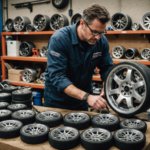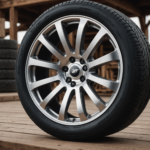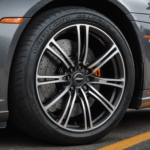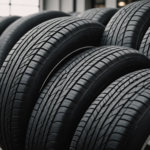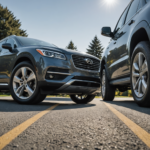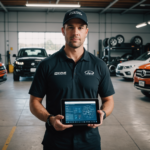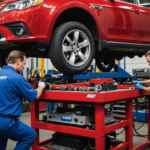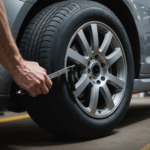Upgrading to aftermarket wheels can significantly enhance a vehicle’s aesthetic appeal and performance. However, choosing the right wheels involves more than just appearance. This article delves into essential factors to consider when shopping for aftermarket wheels, ensuring that enthusiasts make informed decisions that align with their driving needs and preferences.
Understanding Aftermarket Wheels
Aftermarket wheels refer to wheels that are manufactured by a company other than the original equipment manufacturer (OEM). These wheels can provide a variety of styles, sizes, and materials not available through OEM sources. They can enhance the look of a car, improve handling, and even reduce weight.
Benefits of Aftermarket Wheels
- Enhanced Aesthetics: Aftermarket wheels come in various designs that allow customization and personalization, making the vehicle stand out.
- Improved Performance: Many aftermarket wheels are engineered for better handling and performance, contributing to a more dynamic driving experience.
- Reduced Weight: Lighter wheels can decrease unsprung weight, improving acceleration, braking, and cornering capabilities.
- Variety of Options: With numerous brands and styles, consumers can find wheels that fit specific preferences and applications.
Key Factors to Consider When Selecting Aftermarket Wheels
When selecting the ideal aftermarket wheels, several factors must be evaluated:
1. Wheel Size
Determining the proper wheel size is critical as it affects performance, handling, and compatibility. The wheel size encompasses both the diameter and width. Here’s a basic breakdown of how wheel sizing works:
| Size Aspect | Description |
|---|---|
| Diameter | Measured in inches, this reflects the total size from one edge of the wheel to the opposite edge. Common sizes range from 15 to 22 inches. |
| Width | The distance from one side of the wheel to the other, typically ranging from 6 to 12 inches. |
Consider the following when choosing wheel size:
- Vehicle Compatibility: Check the vehicle manufacturer’s specifications to avoid issues with fitment.
- Tire Compatibility: Ensure the selected size accommodates the intended tire specifications.
- Driving Conditions: Different sizes may perform better in various weather or road conditions.
2. Wheel Offset
Wheel offset refers to the distance between the wheel’s mounting surface and the centerline of the wheel. Understanding offset is crucial for both aesthetics and performance:
- Positive Offset: Mounting surface is closer to the outside. This configuration is common in front-wheel-drive vehicles and can improve handling.
- Negative Offset: Mounting surface is further away from the outside. This increases track width and can enhance stability.
- Zero Offset: The mounting surface is aligned with the centerline of the wheel.
When selecting wheels, verifying that the offset aligns with vehicle specifications prevents potential clearance issues with brakes and suspension components.
3. Bolt Pattern
The bolt pattern, or lug pattern, is vital for ensuring the wheel properly fits onto the vehicle. The bolt pattern is expressed in a numerical format that denotes the number of bolts and the distance between them:
- Common Patterns: Examples include 5×114.3, 4×100, and 6×139.7.
- Verification: Always check the vehicle’s manual or the manufacturer’s specifications to ensure compatibility.
4. Material Composition
Aftermarket wheels are primarily made from two materials: alloy and steel. Each material has its advantages and disadvantages:
Alloy Wheels
Composed of aluminum or magnesium, alloy wheels are lighter and often provide better aesthetics.
Steel Wheels
Steel wheels are durable and less prone to damage but are typically heavier and less aesthetically pleasing:
- Pros: Affordability and durability, making them ideal for heavy-duty applications.
- Cons: Heavier weight and less variety in design.
5. Style and Design
The style of aftermarket wheels can drastically change the appearance of a vehicle. Here are some prevalent styles:
- Five-Spoke: A classic design that provides a balance of looks and performance.
- Multi-Spoke: Typically offers a more modern appearance, enhancing the vehicle’s sporty aesthetic.
- Mesh: Provides a contemporary look while allowing for better brake cooling.
Consumers should choose a style that matches their overall vehicle aesthetics and personal preferences.
Installation and Maintenance
Once aftermarket wheels are selected, proper installation and maintenance are vital for longevity and performance:
Installation
Professional installation is recommended to ensure that wheels are mounted correctly, maintaining safety and performance standards:
- Torque Specifications: Follow the vehicle manufacturer’s specifications for lug nut torque.
- Wheel Alignment: After installation, conducting a wheel alignment is crucial to avoid uneven tire wear.
Maintenance
Proper maintenance practices can prolong the life of aftermarket wheels:
- Regular Cleaning: Clean wheels regularly to remove brake dust, road grime, and contaminants.
- Inspection for Damage: Regularly inspect wheels for signs of damage or wear.
- Tire Pressure Monitoring: Check tire pressure regularly to ensure optimal performance and tire longevity.
Conclusion
Upgrading to aftermarket wheels can transform a vehicle’s appearance and performance. However, understanding the key factors—such as size, offset, bolt pattern, material composition, and design—is essential for making informed choices. By paying attention to installation and maintenance, enthusiasts can enjoy the benefits of aftermarket wheels for years to come. With this guide, readers are better equipped to navigate the vast options available and find the perfect fit for their vehicles.






